| August 10, 2007 |  |
our time will build eternity |
| Previous Issues | Aug 09 | Aug 08 | Aug 07 | Aug 06 | Aug 03 |
The Fall Of A Russian Space Chief Moscow (RIA Novosti) Aug 07, 2007
Moscow (RIA Novosti) Aug 07, 2007Nikolai Sevastyanov, now a former president of the Energiya Space Rocket Corporation -- the flagship company of Russia's space industry -- was forced to step down on July 31 despite the support of his top management. Officially, the Russian Space Agency, or Roskosmos, has repeatedly said Sevastyanov's plans, especially those concerned with manned flights, did not fit into the 2006-2015 Federal S ... more A Dreamy Lunar Eclipse For August Skies  Huntsville AL (MSFC) Aug 05, 2007
Huntsville AL (MSFC) Aug 05, 2007Close your eyes, breathe deeply, let your mind wander to a distant seashore: It's late in the day, and the western sun is sinking into the glittering waves. At your feet, damp sand reflects the twilight, while overhead, the deep blue sky fades into a cloudy melange of sunset copper and gold, so vivid it almost takes your breath away. A breeze touches the back of your neck, and you turn to see a ... more NASA Spacecraft Heads For Polar Region Of Mars  Cape Canaveral FL (SPX) Aug 04, 2007
Cape Canaveral FL (SPX) Aug 04, 2007NASA's Phoenix Mars Mission blasted off Saturday, aiming for a May 25, 2008, arrival at the Red Planet and a close-up examination of the surface of the northern polar region. Perched atop a Delta II rocket, the spacecraft left Cape Canaveral Air Force Base at 5:26 a.m. Eastern Time into the predawn sky above Florida's Atlantic coast. "Today's launch is the first step in the long journey to ... more Seeing The Moon Anew  Houston TX (SPX) Aug 05, 2007
Houston TX (SPX) Aug 05, 2007Nearly 40 years after man first walked on the Moon, the complete lunar photographic record from the Apollo project will be accessible to both researchers and the general public on the Internet. A new digital archive - created through a collaboration between Arizona State University and NASA's Johnson Space Center in Houston - is making available high-resolution scans of original Apollo flight fi ... more NASA Selects Astrophysics Projects For New Science On The Moon  Washington (SPX) Aug 03, 2007
Washington (SPX) Aug 03, 2007NASA has selected four proposals focusing on astrophysics priorities in lunar science to facilitate the nation's exploration program. The proposed studies are part of a NASA effort to develop new opportunities to conduct important science investigations during the planned renewal of human exploration of the moon. The newly-announced proposals for concept studies may lead to experiments placed on ... more |
cassini
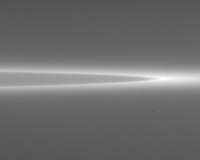 jupiter-moons  spacetravel 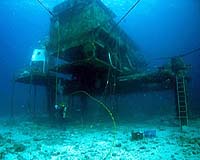 |
 Moffett Field CA (ARC) Jul 24, 2007
Moffett Field CA (ARC) Jul 24, 2007The European Space Agency (ESA), like NASA, has a plan to explore the solar system. ESA's Aurora Programme includes orbiters, landers, rovers, and ultimately, human exploration of the moon and Mars. ExoMars, a rover scheduled to launch in 2011 and to land on Mars in 2013, is one of Aurora's flagship missions. The ExoMars rover will be capable, for the first time since NASA's Viking missions in ... more Throttling Back To The Moon  Huntsville AL (SPX) Jul 24, 2007
Huntsville AL (SPX) Jul 24, 2007Accelerating from 0 to 60 then slowing down for a stop light is no problem for an ordinary automobile. But if you were piloting a rocketship, it wouldn't be so easy. Most rocket engines are designed to burn full-on (liftoff!) or full-off (coasting through space) with no in-between. And that can be a problem--namely, how do you land this thing? Throttling is crucial for a planetary lander. ... more Researchers Produce Images Of Gases Escaping From Jupiter Moon Io  Boston MA (SPX) Jul 21, 2007
Boston MA (SPX) Jul 21, 2007Boston University researchers have published the first clear evidence of how gases from Jupiter's tiny moon's volcanoes can lead to the largest visible gas cloud in the solar system. Jupiter, the largest planet in the solar system, has a moon named Io that is just 100 km larger in radius than Earth's Moon. According to lead researcher Michael Mendillo, professor of electrical and computer engine ... more From Dark Obscurity A Tiny New Saturnian Moon Comes To Light  Boulder C0 (SPX) Jul 21, 2007
Boulder C0 (SPX) Jul 21, 2007Like a hawk's eyes, the high resolution cameras on NASA's Cassini spacecraft have spotted yet another small, previously unknown moon circling giant Saturn and one which may indicate the existence of other small bodies in the same region. The tiny world--presently thought to be only about 2 kilometers (1 mile) wide--orbits at 197,700 kilometers (122,800 miles) from Saturn. Until a name for the mo ... more |
bruce-moomaw
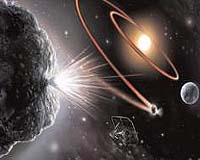 mars-robot 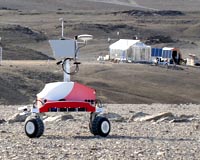 rocketscience 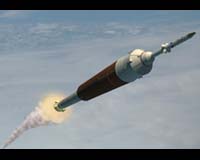 |
 London UK (SPX) Jul 20, 2007
London UK (SPX) Jul 20, 2007"We detected the 60th moon orbiting Saturn using the Cassini spacecraft's powerful wide-angle camera," said Carl Murray, a Cassini imaging team scientist from Queen Mary, University of London. "I was looking at images of the region near the Saturnian moons Methone and Pallene and something caught my eye." The newly discovered moon first appeared as a very faint dot in a series of images Cassini ... more Hidden Lake Could Be Key To Helping Darfur  London (UPI) Jul 20, 2007
London (UPI) Jul 20, 2007A huge lake hidden beneath Darfur and detected by radar from space could be the key to saving lives in the arid, war-torn region. Plans are under way to dig 1,000 wells that could provide water and help stop the region's war, The Telegraph reported Thursday. A team led by a veteran of NASA's Apollo lunar exploration program used satellite equipment to compose a picture of the 12,000-square-mile ... more Saturn Moon Iapetus Retains Its Youthful Figure  Pasadena CA (SPX) Jul 18, 2007
Pasadena CA (SPX) Jul 18, 2007Saturn's distinctive moon Iapetus is cryogenically frozen in the equivalent of its teenage years. The moon has retained the youthful figure and bulging waistline it sported more than three billion years ago, scientists report. "Iapetus spun fast, froze young, and left behind a body with lasting curves," said Julie Castillo, Cassini scientist at NASA's Jet Propulsion Laboratory, Pasadena, Calif. ... more Moonshine Can Reflect Lunar Composition  Phoenix (UPI) Jul 18, 2007
Phoenix (UPI) Jul 18, 2007U.S. scientists determined that they can predict concentrations of certain minerals on the moon by comparing variations in reflected light. Samples of lunar rocks returned by U.S. astronauts show large variations in titanium oxide concentrations, suggesting complex compositional zonation within the lunar mantle. M.S. Robinson of Arizona State University and colleagues, noting ilminite has ... more
|
rocketscience
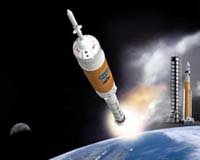 rocketscience 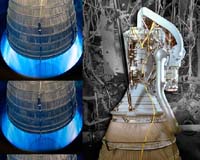 telescopes 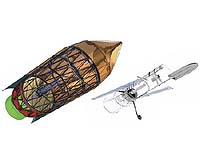 |
| Previous Issues | Aug 09 | Aug 08 | Aug 07 | Aug 06 | Aug 03 |
| The contents herein, unless otherwise known to be public domain, are Copyright 1995-2007 - SpaceDaily. AFP and UPI Wire Stories are copyright Agence France-Presse and United Press International. ESA Portal Reports are copyright European Space Agency. All NASA sourced material is public domain. Additional copyrights may apply in whole or part to other bona fide parties. Advertising does not imply endorsement, agreement or approval of any opinions, statements or information provided by SpaceDaily on any web page published or hosted by SpaceDaily. Privacy statement |